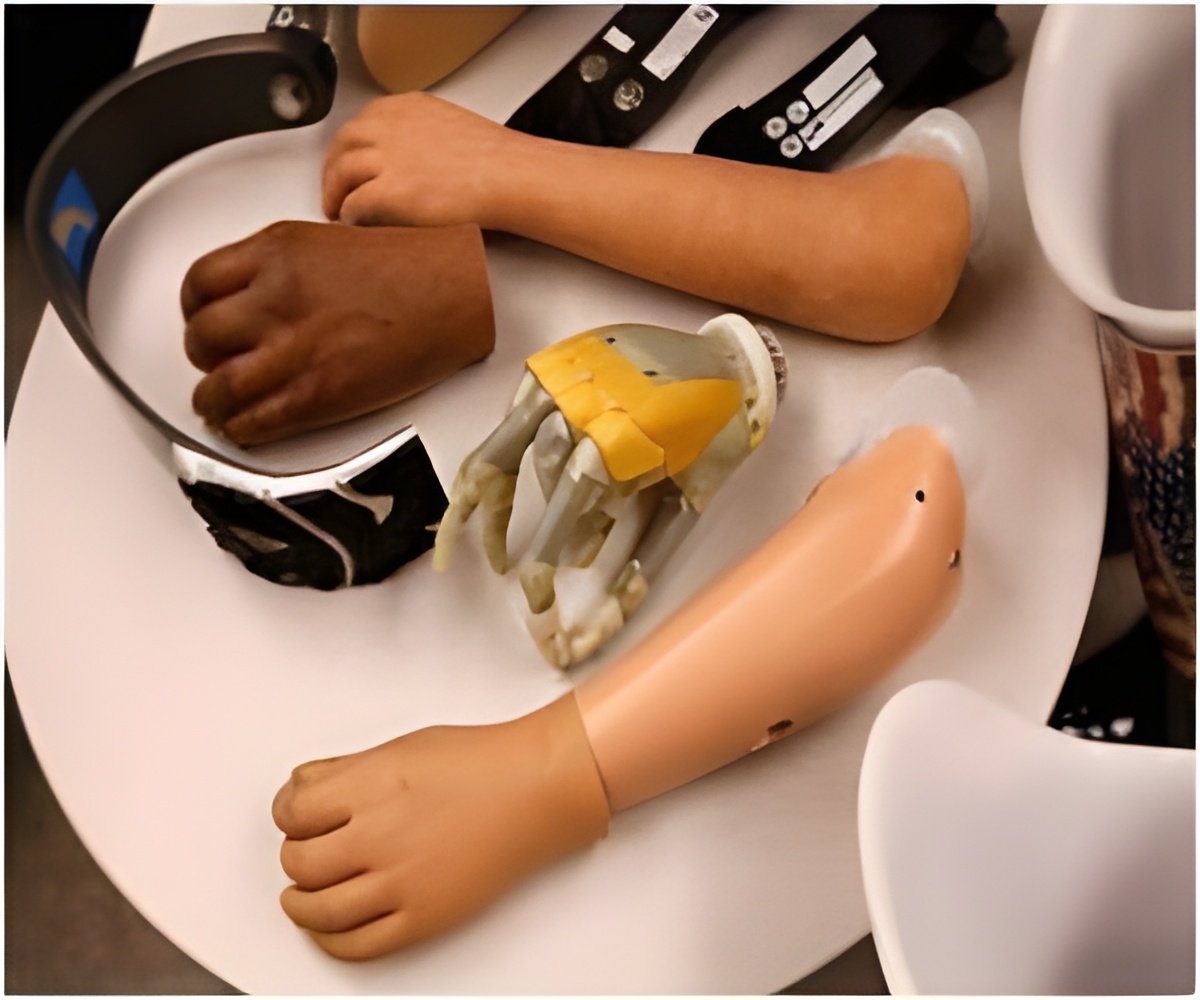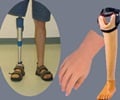Scientists have developed a new approach that set the standards for future limb amputation, according to a new study.

‘A new interface and communication paradigm has been developed to send movement commands from the central nervous system to a robotic prosthesis, and relay proprioceptive back to the central nervous system in return.’





Despite significant improvements to prosthetic devices in recent years, researchers have been unable to provide this essential sensation to people with artificial limbs, limiting their ability to accurately control their movements. Researchers at the Center for Extreme Bionics at the MIT Media Lab have invented a new neural interface and communication paradigm that is able to send movement commands from the central nervous system to a robotic prosthesis, and relay proprioceptive feedback describing movement of the joint back to the central nervous system in return.
This new paradigm, known as the agonist-antagonist myoneural interface (AMI), involves a novel surgical approach to limb amputation in which dynamic muscle relationships are preserved within the amputated limb.
The AMI was validated in extensive pre-clinical experimentation at MIT, prior to its first surgical implementation in a human patient at Brigham and Women's Faulkner Hospital.
In a paper published today in Science Translational Medicine, the researchers describe the first human implementation of the agonist-antagonist myoneural interface (AMI), in a person with below-knee amputation.
Advertisement
To do this, the researchers used the same biological sensors that create the body's natural proprioceptive sensations. The AMI consists of two opposing muscle-tendons, known as an agonist and an antagonist, which are surgically connected in series so that when one muscle contracts and shortens - upon either volitional or electrical activation - the other stretches, and vice versa.
Advertisement
This is how muscle-tendon proprioception works naturally in human joints, Herr says. "Because the muscles have a natural nerve supply, when this agonist-antagonist muscle movement occurs information is sent through the nerve to the brain, enabling the person to feel those muscles moving, both their position, speed and load," he says.
By connecting the AMI with electrodes, the researchers can detect electrical pulses from the muscle, or apply electricity to the muscle to cause it to contract.
"When a person is thinking about moving their phantom ankle, the AMI that maps to that bionic ankle is moving back and forth, sending signals through the nerves to the brain, enabling the person with an amputation to actually feel their bionic ankle moving throughout the whole angular range," Herr says.
Decoding the electrical language of proprioception within nerves is extremely difficult, according to Tyler Clites, first author of the paper and graduate student lead on the project.
"Using this approach, rather than needing to speak that electrical language ourselves, we use these biological sensors to speak the language for us," Clites says. "These sensors translate mechanical stretch into electrical signals that can be interpreted by the brain as sensations of position, speed and force."
The AMI was first implemented surgically in a human patient at Brigham and Women's Faulkner Hospital, Boston, by Matthew J Carty, MD, one of the paper's authors, a surgeon in the Division of Plastic and Reconstructive Surgery and an MIT research scientist.
In this operation, two AMIs were constructed in the residual limb at the time of primary below-knee amputation, with one AMI to control the prosthetic ankle joint, and the other to control the prosthetic subtalar joint.
"We knew that in order for us to validate the success of this new approach to amputation, we would need to couple the procedure with a novel prosthesis that could take advantage of the additional capabilities of this new type of residual limb," Carty says.
"Collaboration was critical, as the design of the procedure informed the design of the robotic limb, and vice versa." Towards this end, an advanced prosthetic limb was built at MIT and electrically linked to the patient's peripheral nervous system using electrodes placed over each AMI muscle following the amputation surgery.
The researchers then compared the movement of the AMI patient with that of four people who had undergone a traditional below-knee amputation procedure, using the same advanced prosthetic limb.
They found that the AMI patient had more stable control over movement of the prosthetic device, and was able to move more efficiently than those with the conventional amputation.
They also found that the AMI patient quickly displayed natural, reflexive behaviors such as extending the toes towards the next step when walking down a set of stairs.
These behaviors are essential to natural human movement, and were absent in all of the people who had undergone a traditional amputation. What's more, while the patients with conventional amputation reported feeling disconnected to the prosthesis, the AMI patient quickly described feeling that the bionic ankle and foot had become a part of their own body.
"This is pretty significant evidence that the brain and the spinal cord in this patient adopted the prosthetic leg as if it were his biological limb, enabling those biological pathways to become active once again," Clites says. "We believe proprioception is fundamental to that adoption."
It is difficult for an individual with a lower limb amputation to gain a sense of embodiment with their artificial limb, according to Daniel Ferris, the Robert W. Adenbaum Professor of Engineering Innovation at the University of Florida, who was not involved in the research.
"This is ground breaking. The increased sense of embodiment by the amputee subject is a powerful result of having better control of and feedback from the bionic limb,"
Ferris says. "I expect that we will see individuals with traumatic amputations start to seek out this type of surgery and interface for their prostheses - it could provide a much greater quality of life for amputees."
The researchers have since carried out the AMI procedure on nine other below-knee amputees, and are planning to adapt the technique for those needing above-knee, below-elbow and above-elbow amputations.
"Previously humans have used technology in a tool-like fashion," Herr says. "We are now starting to see a new era of human-device interaction, of full neurological embodiment, in which what we design becomes truly part of us, part of our identity."
The current study has its roots in a research project that received initial funding in 2014, when Carty was selected as the winner of the inaugural Stepping Strong Innovator Awards granted by The Gillian Reny Stepping Strong Center for Trauma Innovation.
The awards and center were established by a family that survived the Boston Marathon bombings and committed to support ground breaking projects in innovative trauma research and care.
This support allowed the team to quickly focus on all of the foundational work that was necessary to prepare in advance of taking this innovation to the operating room.
Funding for this work was also provided by MIT Media Lab Consortia and a generous gift from Google, Inc. Prosthetic design and fabrication funded in part by US Army MRMC (W81XWH-14-C-0111).
Brigham and Women's Hospital (BWH) is a 793-bed nonprofit teaching affiliate of Harvard Medical School and a founding member of Partners HealthCare. BWH has more than 4.2 million annual patient visits and nearly 46,000 inpatient stays, is the largest birthing center in Massachusetts and employs nearly 16,000 people.
The Brigham's medical preeminence dates back to 1832, and today that rich history in clinical care is coupled with its national leadership in patient care, quality improvement and patient safety initiatives, and its dedication to research, innovation, community engagement and educating and training the next generation of health care professionals.
Through investigation and discovery conducted at its Brigham Research Institute (BRI), BWH is an international leader in basic, clinical and translational research on human diseases, more than 3,000 researchers, including physician-investigators and renowned biomedical scientists and faculty supported by nearly $666 million in funding.
For the last 25 years, BWH ranked second in research funding from the National Institutes of Health (NIH) among independent hospitals. BWH is also home to major landmark epidemiologic population studies, including the Nurses' and Physicians' Health Studies and the Women's Health Initiative as well as the TIMI Study Group, one of the premier cardiovascular clinical trials groups.
For more information, resources and to follow us on social media, please visit BWH's online newsroom.
Source-Eurekalert













